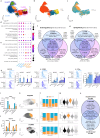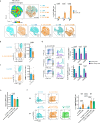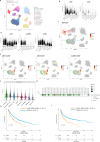Interleukin-35 impairs human NK cell effector functions and induces their ILC1-like conversion with tissue residency features
- PMID: 40610398
- PMCID: PMC12229632
- DOI: 10.1038/s41467-025-61196-0
Interleukin-35 impairs human NK cell effector functions and induces their ILC1-like conversion with tissue residency features
Abstract
Natural Killer (NK) cells play pivotal immunological roles including direct cytotoxic effector function and secretion of inflammatory and immunomodulating cytokines. In the context of chronic inflammation, NK cell fitness decreases during disease progression through currently unknown mechanisms. Here, we demonstrate that Interleukin-35 (IL-35) inhibits human NK cell proliferation, pro-inflammatory, and cytotoxic functions, while promoting secretion of TGF-β and proangiogenic factors in vitro. We show prolonged exposure to IL-35 converts both conventional and adaptive NK cells into CD9+CD103+CD49a+ ILC1-like cells via autocrine TGF-β. We assess cancer patient-derived public datasets and reveal the presence of IL-35-producing cells and IL-35-receptor-expressing NK/ILC1-like cells within the tumor microenvironment and associate IL-35 with poor prognosis. Collectively, our findings identify and implicate IL-35 as a key driver of NK cell plasticity, promoting the acquisition of features associated with tissue residency and weakened effector functions, and could be relevant in pathophysiological contexts, highlighting IL-35 as an attractive target for future immunotherapies aimed at enhancing NK cell clinical activity.
© 2025. The Author(s).
Conflict of interest statement
Competing interests: The authors declare no competing interests.
Figures







References
-
- Vivier, E. et al. Innate Lymphoid Cells: 10 Years On. Cell174, 1054–1066 (2018). - PubMed
-
- Malmberg, K.-J. et al. Natural Killer Cell-Mediated Immunosurveillance of Human Cancer. Semin Immunol.31, 20–29 (2017). - PubMed
-
- Wolf, N. K., Kissiov, D. U. & Raulet, D. H. Roles of Natural Killer Cells in Immunity to Cancer, and Applications to Immunotherapy. Nat. Rev. Immunol.23, 90–105 (2023). - PubMed
-
- Huntington, N. D., Cursons, J. & Rautela, J. The Cancer-Natural Killer Cell Immunity Cycle. Nat. Rev. Cancer20, 437–454 (2020). - PubMed
MeSH terms
Substances
Grants and funding
- INCa-DGOS-INSERM-ITMO cancer/Institut National Du Cancer (French National Cancer Institute)
- PLBIO-16-116/Institut National Du Cancer (French National Cancer Institute)
- PJA20181208305/Fondation ARC pour la Recherche sur le Cancer (ARC Foundation for Cancer Research)
- EL2020.LNCC-CHC/Ligue Contre le Cancer
- ANR-11-IDEX-0007/Agence Nationale de la Recherche (French National Research Agency)
LinkOut - more resources
Full Text Sources
Research Materials

